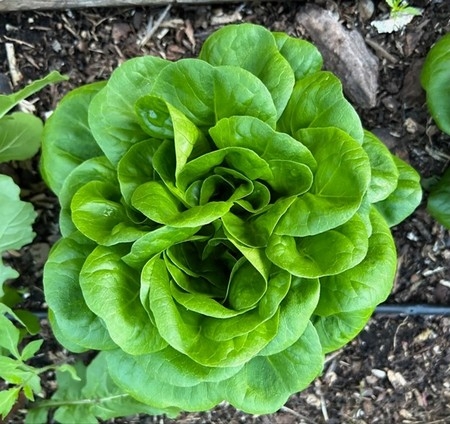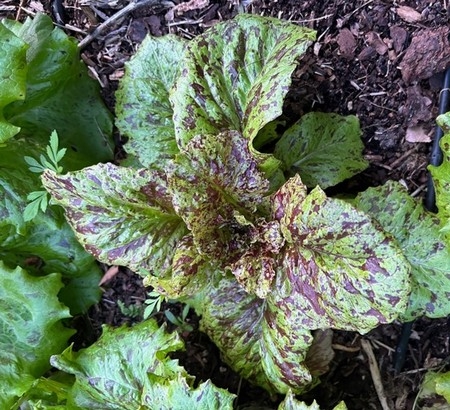Lettuce may not be a garden crop that causes you to perk up and say, “Tell me more.” You may be thinking, “Boring, I'll pass.” Or you may be the gardener who says, “I never could get that crop to grow.” Whatever your current thinking about lettuce, I hope to get you excited about this humble crop. There are not many garden vegetables with more diversity than lettuce, with more than 100 varieties in a wide range of colors, textures, and shapes.
If you need more encouragement, lettuce is a great hydrator, being 95% water. Lettuce is a powerhouse when it comes to vitamins and minerals. Vitamins A and C play a strong role in supporting the immune system, eyesight, and reduce inflammation. Iron, folic acid, calcium and potassium also add to the health benefits of lettuce.
Lettuce (Lactuca sativa) has been cultivated for thousands of years. The name is derived from the milky liquid produced when a leaf is broken from the stem.
Cool Season vs. Warm Season
We tend to think of lettuce as a light summer food, but lettuce is a cool weather crop. The optimum growing conditions for lettuce occur in fall and early spring. Many cool season lettuce varieties have good tolerance for cold temperatures and do well in low-light conditions.
Summer lettuce is in high demand as a crop, causing breeders to develop lettuce varieties for summer growing conditions with good success. These lettuce varieties are bred specifically to be heat tolerant and are slow to bolt and less bitter as they mature.
Seed Germination & Transplants
Lettuce seeds will germinate in 3–10 days depending on conditions.
Seeds can germinate in soils as low as 40°F but germination will be slow. The optimum temperature for seed germination is 55°–65°F. Above 70°F lettuce seeds germinate poorly, resulting in undersized, misshapen, elongated heads. At higher temperatures lettuce seeds may completely fail to germinate.
Fall lettuce seeds need to be in the ground in late September so they can reach 75% maturity going into the low-light days and cool nights of our winter months.
Spring lettuce seeds should be started indoors in early February. This will give you a jump on planting out in the spring after all danger of frost is past. Continue to sow seeds at 2-week intervals for continuous production.
Lettuce seeds are very small and should be planted with a very light covering of soil (¼ inch). Be generous when sowing your seeds, as some will not germinate, and others may be lost to birds. As they mature, the thinnings can be added to salad or used in sandwiches. The final spacing for lettuce plants should be 9–12 inches.
Many gardeners start with lettuce transplants from a local nursery, followed by seed sowing at 2-week intervals. This gets you off to a quick start and keeps you in a continuous supply of lettuce. To keep your lettuce crop growing through the summer switch to a variety listed as heat tolerant or slow-to-bolt.
Soil Preparation
Lettuce does best in loose, well-drained soil with a generous addition of compost added before planting. A source of organic nitrogen can also be added to the soil before planting. Alfalfa meal, cottonseed meal, and fish or kelp meal are all good sources for slow, consistent nitrogen release.
Watering & Fertilizing
Keep the top 1–3 inches of the soil consistently moist as lettuce roots are shallow and dry out easily. You will want to provide adequate nitrogen for this fast-growing crop. Organic fertilizer is slower to become available. If you are using transplants, give them an application of liquid fertilizer 2 weeks after transplanting.
Frost Protection & Shade Cloth
Winter grown lettuce, though it can tolerate cool temperatures, will need protection from frost, while summer grown lettuce must have some shade protection.
Harvesting
Many lettuces can be harvested as baby greens. Some of the looseleaf varieties can be harvested in any stage of development by cutting the larger outside leaves and leaving the smaller inner leaves to mature. Mature lettuce does not get better, it gets bitter, so don't wait to harvest. To keep lettuce at peak freshness, harvest early in the morning. Wash the leaves thoroughly in cold water, then remove as much excess moisture as you can—a salad spinner is a great tool for this job. Store lettuce in the refrigerator in a plastic container with a lid with several damp paper towels added to create a humid environment. Garden fresh lettuce, stored in this manner, will last 7–14 days.
Disease & Pests
The most common diseases of lettuce are Botrytis rot, lettuce mosaic virus, and mildew. Keeping lettuce leaves dry is the best way to avoid disease from getting a foothold. Good air circulation and drip irrigation are two helpful practices.
Lettuce may fall prey to occasional pests including cutworms, leafminers, caterpillars, aphids, whitefly, snails/slugs and earwigs. Access the UC IPM website for information on controlling specific disease, insects, and vertebrate pests such as birds and deer.
https://ipm.ucanr.edu/home-and-landscape/lettuce/index.html
Lettuce Types
Butterhead / Boston / Bibb: These lettuce varieties form a round, loose head. They range from delicate and buttery to bright and crisp. Leaves tend to be large, making them an excellent choice for wraps and sandwiches. *Days to maturity 45–55. These varieties can be harvested anytime during development.
Looseleaf: This lettuce grows from a central stalk but does not form a head. These varieties are easy to grow and perform well in shaded areas or in low light. They are tolerant of warm temperatures and are slow to bolt which make them a good choice for multi-season growing. *Days to maturity 45-55. These varieties can be harvested anytime during development.
Crisphead / Summercrisp / Batavian: These lettuce varieties are known for their crisp snap and sweet flavor. They form a round, compact head. Often the outer leaves are darker with tender light leaves in the interior. Crisphead is a true cool weather variety which will stand up to very cool temperatures but beware, it is quick to bolt when temperatures rise and it's a favorite of snails and slugs. This would be a good choice for starting indoors in January for transplanting in February after all danger of frost is past. *You will need to plan ahead as some of these varieties take 70-100 days to reach full maturity.
Cos / Romaine: This lettuce is very upright, forming a column. They can be tightly closed, semi-closed, or open heads. This lettuce has a crisp, creamy white heart with the outer leaves remaining sturdy and dark. It is unforgiving of poor growing conditions and is not well adapted to warm weather. There are interesting varieties in the seed catalogs with some beautiful deep burgundy varieties in the offering. *You will need to plan ahead as some of these varieties take 75-85 days to reach full maturity.
I hope I have piqued your interest in experimenting with both winter and summer lettuce in your garden. The varieties and variations are truly exciting, many of which you will never see in your supermarket or even at farmers markets. Whether you select your varieties by color, shape, texture, or even their fun names, I hope you have decided to give lettuce a place in your garden. May it be a delightful and successful experience!
Help Desk of UC Master Gardener Program of Contra Costa County (BHD)

